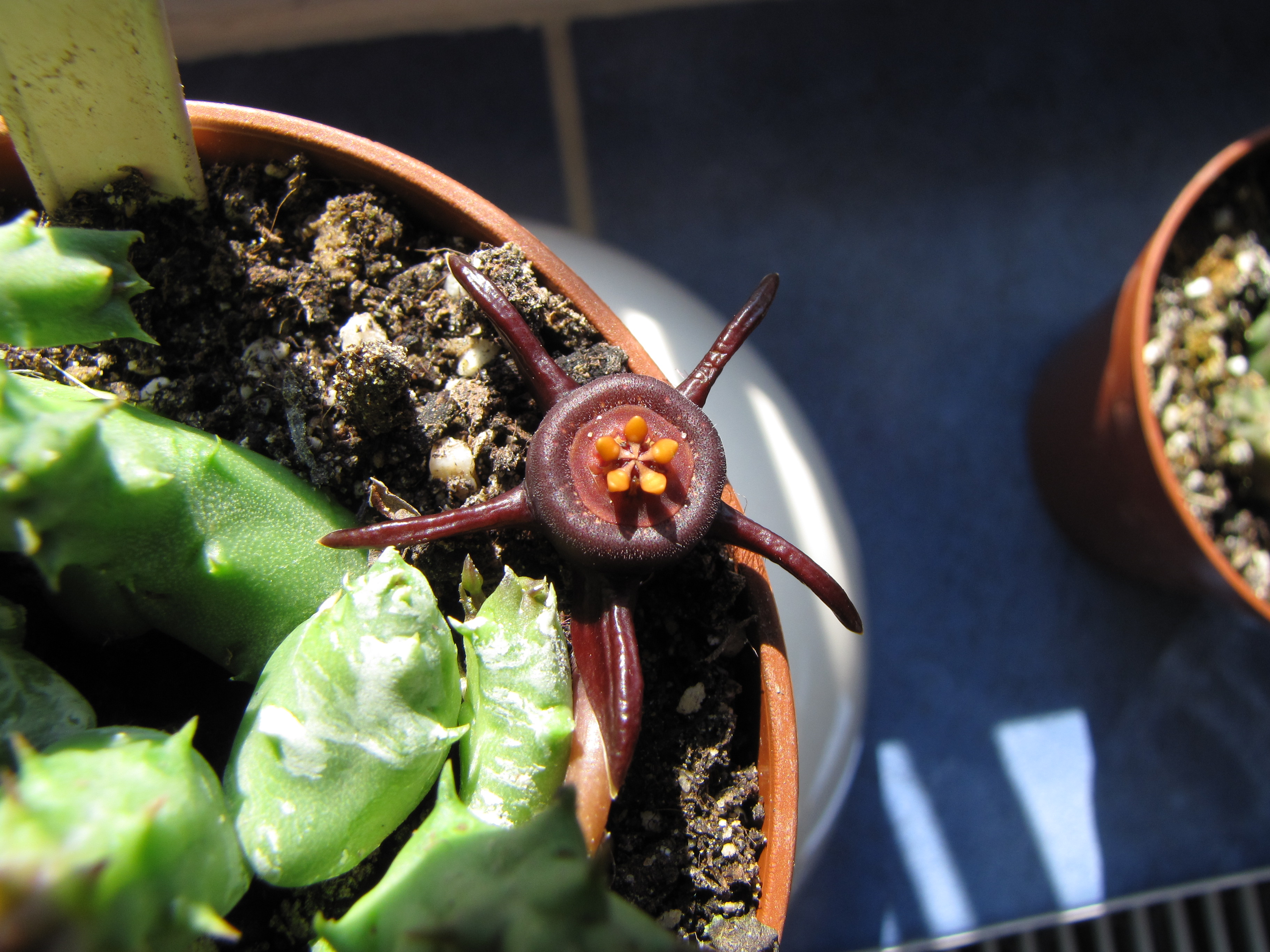Duvalia Corderoyi on:
[Wikipedia]
[Google]
[Amazon]
''Duvalia'' is a succulent plant genus in the subfamily Asclepiadoideae, in the family Apocynaceae (dogbane).
The genus was first described in 1812, named after the French physician and botanist Henri-Auguste Duval (1777-1814).




/ref> ;formerly included transferred to ''
Description




Vegetative
The ''Duvalia'' species are succulent, perennial plants with low, planar growth. The stems are clavate, cylindrical to spherical, in cross-section four-, five-or six-edged, and to about 10 inches long. They can range from green, gray to mottled reddish in color. The stems of some species, such as the rounded ''Duvalia parviflora
''Duvalia'' is a succulent plant genus in the subfamily Asclepiadoideae, in the family Apocynaceae (dogbane).
The genus was first described in 1812, named after the French physician and botanist Henri-Auguste Duval (1777-1814).
Description
...
'', are distinctive, and these species can be identified even when not in flower. However the stems are very variable, and most ''Duvalia'' species can only be distinguished from each other when the flower is seen.
The stems are superficially very similar to those of the related genus ''Piaranthus
''Piaranthus'' is a succulent plant genus in the subfamily Asclepiadoideae, in the family Apocynaceae.
It was first described in 1810. Its name comes from Greek and is descriptive of the fleshy, succulent flowers typical of the genus (''"piar-" ...
'', and the two are often confused when not in flower. In cross-section, ''Duvalia'' stems are sometimes five or six sided (''Piaranthus
''Piaranthus'' is a succulent plant genus in the subfamily Asclepiadoideae, in the family Apocynaceae.
It was first described in 1810. Its name comes from Greek and is descriptive of the fleshy, succulent flowers typical of the genus (''"piar-" ...
'' stems are always four-sided in cross-section). To accurately distinguish them however, it is necessary to examine the flowers.
Floral
The distinctive flowers are on long, bare stalks, which grow from the base of the stems. Each flower has five thin, elongated petal-like lobes, radiating in a star-shape, from a central raised disk orannulus
Annulus (or anulus) or annular indicates a ring- or donut-shaped area or structure. It may refer to:
Human anatomy
* ''Anulus fibrosus disci intervertebralis'', spinal structure
* Annulus of Zinn, a.k.a. annular tendon or ''anulus tendineus com ...
.
The colour of most species flowers is shades of reddish brown, except for those of the rare ''Duvalia parviflora
''Duvalia'' is a succulent plant genus in the subfamily Asclepiadoideae, in the family Apocynaceae (dogbane).
The genus was first described in 1812, named after the French physician and botanist Henri-Auguste Duval (1777-1814).
Description
...
'' which are cream-coloured. The hermaphroditic flowers measure 1–5 cm in diameter, and have five parts. The crown is yellow ocher, brown, red to dark purple. The five corolla lobes are flat or folded along the middle nerve.
Distribution
It occurs in southern Africa. The majority of the species are restricted to the western part of South Africa & Namibia, with the greatest number of species occurring in the Great Karoo region, on the edge of the winter rainfall area. Only one species, ''Duvalia polita
''Duvalia'' is a succulent plant genus in the subfamily Asclepiadoideae, in the family Apocynaceae (dogbane).
The genus was first described in 1812, named after the French physician and botanist Henri-Auguste Duval (1777-1814).
Description
...
'' extends further east, and as far north into tropical Africa as Malawi and Zambia.
Four species, occurring on the other side of the continent on the verges of the Red Sea, were formerly included in the genus ''Duvalia''. However phylogenetic studies have shown them to be relatively unrelated to the rest of the genus, and more closely related to genus ''Ballyanthus
''Ballyanthus'' is a genus of flowering plants belonging to the family Apocynaceae.
Its native range is Somalia.
Species:
*'' Ballyanthus major''
*'' Ballyanthus prognathus''
References
{{Taxonbar, from=Q15970712
Apocynaceae
Apocynac ...
'' Bruyns.P. Bruyns, C. Klak, P. Hanacek: ''Evolution of the stapeliads (Apocynaceae-Asclepiadoideae) - repeated major radiation across Africa in an Old World group. Molecular Phylogenetics and Evolution.'' 2014. v. 77, no. 1, p. 251--263. ISSN 1055-7903.
;SpeciesThe Plant List, ''Duvalia''/ref> ;formerly included transferred to ''
Mannia
''Mannia'' is a genus of liverworts belonging to the family Aytoniaceae. It has a cosmopolitan distribution.
Species
The following species are recognised in the genus ''Mannia'':
* ''Mannia androgyna'' (L.) A. Evans
* ''Mannia californica'' ( ...
''
*''Duvalia rupestris'' now '' Mannia rupestris''
References
''Portions of this page were translated from the equivalent page on the German wikipedia accessed July 3, 2012'' {{Taxonbar, from=Q291868 Apocynaceae genera